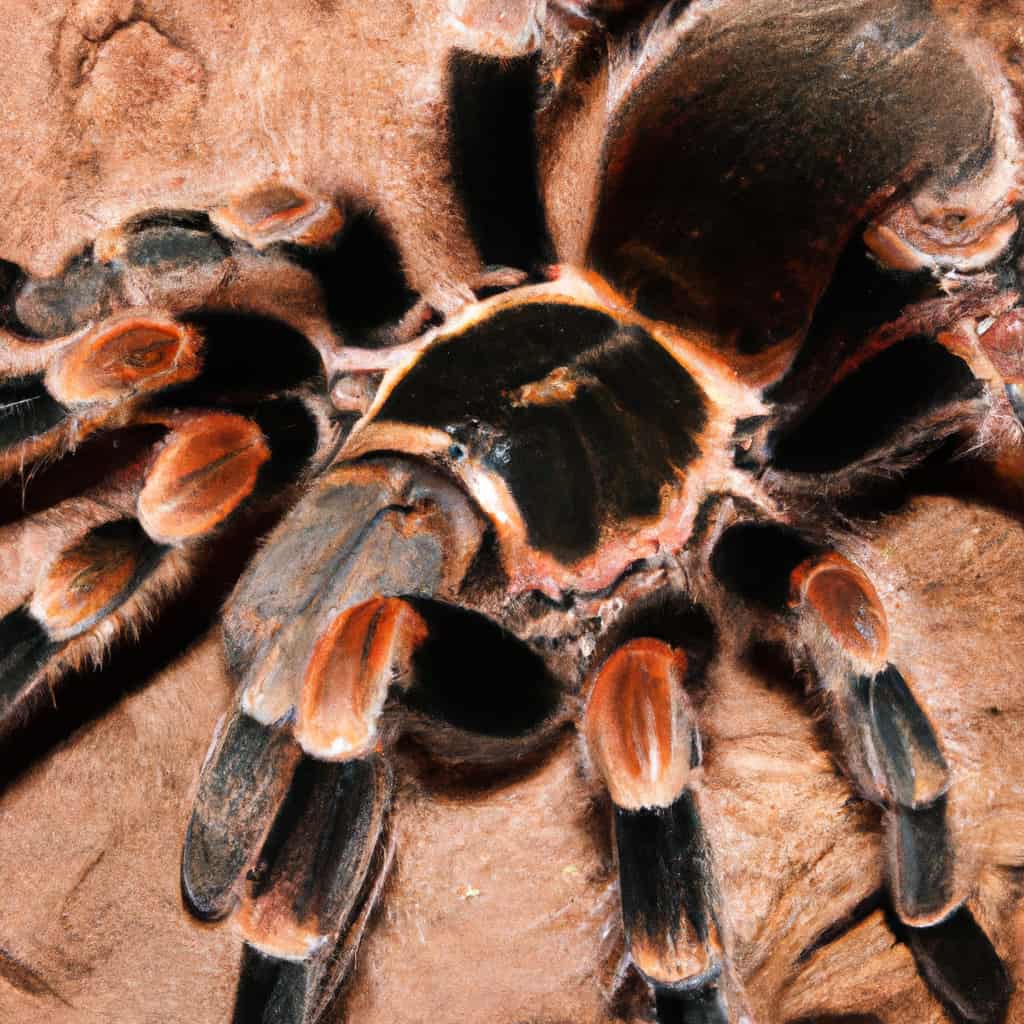Have you noticed a bald spot on your tarantula? Don’t worry, you’re not alone. This is a common phenomenon among tarantula keepers, and there are several reasons why your tarantula might be experiencing hair loss.
Understanding tarantulas and their anatomy is crucial in determining the cause of a bald spot. Tarantulas have a unique defense mechanism called urticating hairs, which they can kick off when threatened. Additionally, tarantulas go through a molting process where they shed their old exoskeleton and grow a new one. These factors can contribute to the development of a bald spot on your tarantula. In this article, I will explore the various reasons why your tarantula might have a bald spot and provide tips on how to prevent it from happening.
Key Takeaways
- Bald spots on tarantulas can be caused by several factors, including molting, urticating hairs, and stress.
- Proper tarantula care and handling can help prevent bald spots from developing.
- If you notice a bald spot on your tarantula, consult with a veterinarian or experienced tarantula keeper to determine the cause and appropriate treatment.

Understanding Tarantulas and Their Anatomy
As a tarantula owner, it is important to understand the anatomy of your pet. Tarantulas have two main body parts: the cephalothorax, which contains the head and thorax, and the abdomen. The cephalothorax is covered by a hard exoskeleton, called the carapace, which provides protection. The abdomen is soft and contains the tarantula’s vital organs.
Tarantulas have eight legs, which are attached to their cephalothorax. The legs are covered in tiny hairs, which help the tarantula sense its environment. Tarantulas are also known for their ability to regenerate lost limbs.
There are two main types of tarantulas: terrestrial and arboreal. Terrestrial tarantulas live on the ground, while arboreal tarantulas live in trees. New world tarantulas are found in the Americas, while old world tarantulas are found in Asia, Africa, and Australia.
One of the most common concerns for tarantula owners is a bald spot on the abdomen. This can be caused by a few different factors, including molting and urticating hairs. Before molting, tarantulas may develop a bald spot on their abdomen, which will disappear after they molt. New world tarantulas also have the ability to kick off their urticating hairs, which can leave a bald spot on their abdomen.
Tarantula Molting Process
As a tarantula owner, it’s important to understand the molting process to ensure your pet stays healthy. Molting is a natural process in which the tarantula sheds its exoskeleton to grow. This process can take several hours and can be stressful for the tarantula, so it’s important to provide a stress-free environment during this time.
Signs of a Molting Tarantula
There are several signs that your tarantula may be molting. These include:
- Decreased activity: Your tarantula may become less active and move around less than usual.
- Bald spot: Some tarantulas will lose hair on their abdomens leading up to a molt.
- Spinning webs: Your tarantula may spin webs in its enclosure to create a safe space for molting.
- Darkening: Your tarantula’s exoskeleton may darken in color before the molt.
If you notice any of these signs, it’s important to provide a stress-free environment for your tarantula during the molting process.
Successful Molting
It’s important to provide the right environment for your tarantula during the molting process to ensure a successful molt. Here are some tips to help your tarantula through the molting process:
- Provide a safe space: Your tarantula may spin webs to create a safe space for molting. Make sure to provide enough space and substrate for your tarantula to create this space.
- Keep the enclosure humid: A humid environment can help your tarantula shed its exoskeleton more easily. You can mist the enclosure or provide a water dish to help keep the humidity levels up.
- Don’t disturb your tarantula: It’s important to leave your tarantula alone during the molting process. Disturbing your tarantula can cause stress and potentially harm the molting process.
By following these tips, you can help ensure a successful molting process for your tarantula.
The Bald Spot Phenomenon
If you’re a tarantula owner, you may have noticed a bald spot or patch on your pet’s abdomen. Don’t worry, this is a common occurrence and can be caused by a few different reasons. In this section, I’ll go over the reasons for bald spots and explain the difference between a bald patch and a bald spot.
Reasons for Bald Spots
There are a few reasons why your tarantula may have a bald spot. One of the most common reasons is molting. As the molt approaches, the bald spot on the abdomen will grow darker. After molting, the bald spot will be gone, and the tarantula will have a fresh new coat of hair.
Another reason for bald spots is stress. If your tarantula is stressed or excited, it may lose hair or develop a bald spot. This can be caused by handling or opening the tarantula’s cage, or it may feel threatened for another reason.
Finally, bald spots can also occur in New World tarantulas that have been kicking off their urticating hairs. These hairs are used as a defense mechanism and can leave the tarantula with a bald patch on their rump.
Bald Patch vs Bald Spot
It’s important to understand the difference between a bald patch and a bald spot. A bald patch is an area where the hair has been rubbed off due to friction. This can happen if your tarantula is rubbing against the substrate or decorations in its enclosure. A bald spot, on the other hand, is a spot where the hair has fallen out or been removed.
If you notice a bald patch on your tarantula, it’s important to make sure the substrate and decorations in the enclosure are not too rough or abrasive. You may also want to check for mites or other parasites that could be causing the bald patch.
The Role of Urticating Hairs
As a tarantula owner, it can be concerning to see your pet with a bald spot. One of the reasons why tarantulas develop bald patches is due to their urticating hairs. These specialized hairs are a crucial part of a tarantula’s defense mechanism. In this section, I will discuss how tarantulas use their hairs and the consequences of losing them.
How Tarantulas Use Their Hairs
Tarantulas have specialized hairs on their abdomen called urticating hairs. These hairs are barbed and can cause itching, irritation, and even allergic reactions in predators or threats. When a tarantula feels threatened, it can flick these hairs off its abdomen and onto the predator or threat. The hairs can get into the predator’s eyes, nose, or mouth, causing discomfort and allowing the tarantula to escape.
Tarantulas can also use their hairs to protect their eggs. They will place the hairs on their molting mats and cocoons with fertilized eggs as an extra protective measure. Tarantulas are intelligent creatures that use all of their defenses to protect themselves and their offspring.
Consequences of Losing Hairs
One of the main reasons why your tarantula may have a bald spot is because it has lost its urticating hairs. Losing hairs can be a natural part of the molting process, but it can also be due to stress or illness. If your tarantula is losing hairs due to stress, you should evaluate its living conditions and make sure it has a suitable environment. If your tarantula is losing hairs due to illness, you should take it to a veterinarian who specializes in exotic animals.
Stress Factors for Tarantulas
As a tarantula owner, it’s important to understand the various stressors that can affect your pet. Stress can cause your tarantula to lose hair and develop bald spots. Here are some factors that can cause stress in tarantulas:
Environmental Stressors
Environmental stressors can be caused by changes in the tarantula’s environment. For example, if you recently moved your tarantula to a new enclosure, it may take some time for it to adjust to the new environment. Similarly, if the humidity levels in the enclosure are not suitable for your tarantula’s species, it can cause stress. It’s important to research the specific needs of your tarantula’s species and make sure that the enclosure meets those needs.
Behavioral Stressors
Behavioral stressors are caused by the tarantula’s behavior or actions. Handling your tarantula too often or inappropriately can cause stress. Tarantulas are not social creatures and prefer to be left alone. Additionally, loud noises, bright lights, and sudden movements can also cause stress. If you notice that your tarantula is hiding more often than usual, it may be a sign that it’s feeling stressed.
Tarantula Health and Age
How to Detect a Sick Tarantula
As a tarantula owner, it’s important to be able to recognize signs of illness in your pet. Here are some things to look out for:
- Lethargy or lack of movement
- Refusal to eat
- Difficulty walking or climbing
- Abnormal posture or positioning
- Discoloration or unusual markings on the body
- Excessive hair loss or bald spots
- Abnormal secretion of fluids
If you notice any of these symptoms, it’s important to seek veterinary care for your tarantula as soon as possible. Delaying treatment can lead to further health complications and even death.
Age and Its Effects on Tarantulas
Like all living creatures, tarantulas age over time. As they get older, their bodies may become more fragile and susceptible to illness. Some signs that your tarantula may be aging include:
- Slower movement and activity levels
- Reduced appetite or difficulty digesting food
- Increased susceptibility to infections or parasites
- Changes in coloration or markings on the body
- Loss of hair or bald spots
While it’s impossible to completely prevent the effects of aging, there are steps you can take to help your tarantula live a long and healthy life. Providing a stable environment with proper temperature and humidity levels, a nutritious diet, and regular veterinary check-ups can all help to keep your tarantula healthy and happy.
Tarantula Care and Handling
As a tarantula owner, it is important to provide proper care and handling to ensure the health and well-being of your pet. Here are some tips on how to care for your tarantula.
Appropriate Feeding
Tarantulas are carnivorous and require live prey to eat. The size of the prey should be appropriate for the size of the tarantula, with larger tarantulas being able to eat larger prey. Some common prey items include crickets, mealworms, and roaches.
It is important to never leave uneaten prey in the tarantula’s enclosure, as this can lead to stress and potential health issues. If the tarantula does not eat the prey within a few hours, remove it from the enclosure.
Providing a Safe Den
Tarantulas require a hiding spot in their enclosure to feel safe and secure. This can be a small box or even a piece of cork bark. It is important to ensure that the hiding spot is secure and cannot be easily knocked over or moved.
In addition to a hiding spot, tarantulas also require a suitable den to live in. This can be a simple plastic container or a more elaborate terrarium. The den should be large enough for the tarantula to move around in, but not so large that it becomes difficult to find the tarantula.
Tarantulas and Their Predators
Tarantulas have a variety of predators in the wild, including birds, snakes, lizards, and small mammals. These predators are always on the lookout for an easy meal, and tarantulas are no exception. However, tarantulas have developed a number of defense mechanisms to protect themselves from these predators.
One of the most well-known defense mechanisms of tarantulas is their ability to flick urticating hairs from their abdomen when threatened. These hairs are irritating to the predator and can cause skin irritation and discomfort. In some cases, the hairs can even cause blindness if they get into the predator’s eyes.
Another defense mechanism of tarantulas is their ability to bite. While tarantula bites are not usually fatal to humans, they can cause pain, swelling, and other symptoms. Tarantulas will generally only bite if they feel threatened or cornered, so it’s best to give them plenty of space and avoid handling them if possible.
In addition to these physical defense mechanisms, tarantulas also use their environment to protect themselves. They may burrow underground to avoid predators or hide under rocks and other debris. Some tarantulas even use their camouflage to blend in with their surroundings and avoid detection.
Overall, tarantulas have developed a number of effective defense mechanisms to protect themselves from predators in the wild. While they may seem intimidating, they are generally not aggressive towards humans and will only bite if they feel threatened. If you’re considering keeping a tarantula as a pet, it’s important to understand their natural behavior and needs to ensure that they stay healthy and happy.
Case Study: Mexican Red Knee Tarantula
I recently received a question from a tarantula keeper who noticed a bald spot on their Mexican Red Knee Tarantula’s abdomen. The keeper was worried and asked if it was something to be concerned about.
First, it’s important to note that bald spots on tarantulas are not uncommon. In fact, it’s a natural part of the molting process for many species. When a tarantula is preparing to molt, it will shed the hairs on its abdomen to make room for its new exoskeleton.
However, it’s also possible that the bald spot could be a sign of a health issue. In some cases, tarantulas can develop infections or parasites that cause hair loss.
To determine the cause of the bald spot, it’s important to closely monitor the tarantula’s behavior and overall health. If the bald spot is accompanied by other symptoms such as lethargy or loss of appetite, it’s best to consult with a veterinarian who specializes in exotic pets.
In the case of the Mexican Red Knee Tarantula, it’s important to note that they are generally hardy and easy to care for. These tarantulas are native to the Pacific coast of Mexico and are known for their vibrant reddish-orange “knees” and generally docile temperament.
When keeping a Mexican Red Knee Tarantula as a pet, it’s important to replicate their natural habitat as closely as possible. This means providing a substrate of peat moss, soil, and vermiculite, as well as a hide for the tarantula to retreat to.
Conclusion
In conclusion, if you notice your pet tarantula has a bald spot, don’t panic. It’s a natural part of the molting process and can also be a sign of stress or excitement. Bald spots can occur on the abdomen or other parts of the body due to normal wear and tear or urticating setae flicking.
To help prevent stress in your tarantula, avoid handling or disturbing it during the molting process. Make sure to provide a suitable environment and diet for your pet to minimize stress levels.
If you notice a bald spot on your tarantula, monitor it closely. If it becomes darker as the molting process approaches, it’s a good sign that your tarantula is healthy and preparing for molting. However, if the bald spot is accompanied by other symptoms such as lethargy or loss of appetite, it may be a sign of illness or injury. In this case, it’s important to seek advice from a veterinarian or experienced tarantula keeper.
Remember, tarantulas are fascinating and unique pets, but they require specialized care and attention. By understanding the causes and implications of bald spots, you can help ensure the health and happiness of your pet tarantula.
Frequently Asked Questions
What are the signs of tarantula premolt?
Before molting, tarantulas may exhibit some signs. They may become less active, stop eating, and become more reclusive. You may also notice a bald spot on their abdomen that grows increasingly darker as the molt draws near. After molting, the bald spot will be gone.
How can I tell if my tarantula is dehydrated?
Dehydration is a common problem for tarantulas. Signs of dehydration include a shriveled abdomen, lethargy, and difficulty moving. To prevent dehydration, make sure that your tarantula always has access to fresh water.
Why is my tarantula’s abdomen so big?
A swollen abdomen can be a sign of a variety of issues, including overfeeding, constipation, or even an internal infection. If your tarantula’s abdomen is swollen, it’s best to consult with a veterinarian who specializes in exotic pets.
Will my tarantula’s hair grow back after bald spots?
Yes, tarantula hair will grow back after bald spots. However, it may take several molts before the hair is fully restored.
Do tarantulas go bald if you stroke them?
No, tarantulas do not go bald if you stroke them. Bald spots are usually a sign of stress or approaching molt.
Why is my tarantula’s bald spot turning black?
A bald spot that turns black may be a sign of an infection or injury. If you notice this, it’s best to consult with a veterinarian who specializes in exotic pets.








